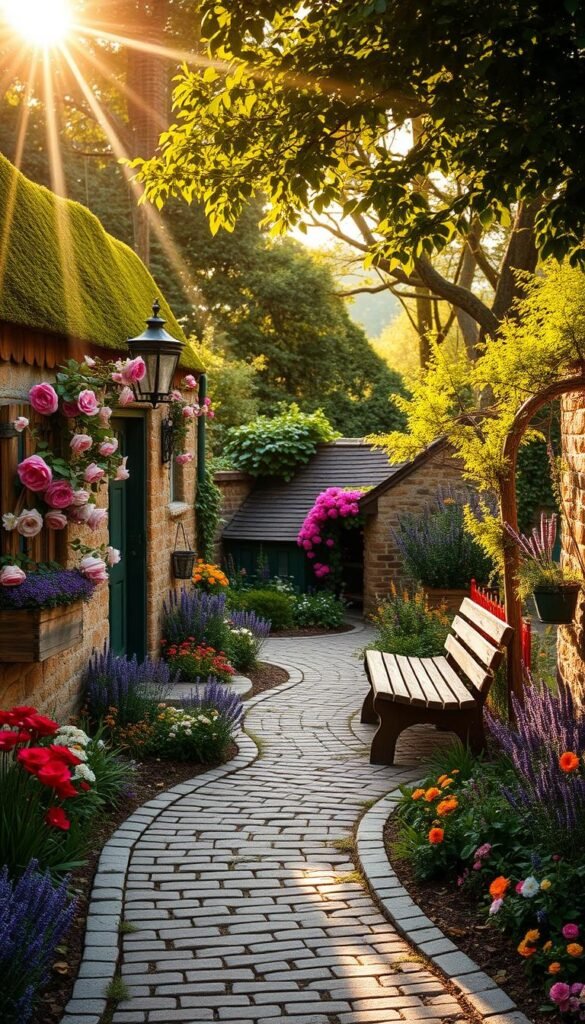Imagine stepping into a space where time slows, and nature’s whimsy takes center stage. This is the magic of designing outdoor areas inspired by centuries-old traditions that blend practicality with beauty. Originally born from 15th-century homesteads, these landscapes prioritized herbs and vegetables for survival. By the 1800s, they evolved into Victorian-era floral showcases, reflecting a growing love for ornamental blooms.
Today, this style celebrates unstructured elegance—think overflowing blooms, meandering pathways, and a mix of textures that mimic nature’s spontaneity. It’s not about perfection but about creating a living canvas that feels both intentional and wild. The philosophy embraces abundance, where plants like foxgloves and lavender mingle freely, offering year-round color and fragrance.
What makes these spaces so captivating? They balance planned creativity with organic growth. You’ll learn how to layer heights, choose complementary hues, and incorporate vintage accents for a timeless feel. For deeper inspiration, explore how the cottagecore aesthetic merges nostalgia with modern gardening techniques.
Whether you’re working with a sprawling yard or a cozy corner, this approach invites you to reconnect with the earth’s rhythms. It’s about crafting a sanctuary that whispers stories of simpler times while thriving in today’s world.
Setting the Stage: Embracing the Cottagecore Garden Style
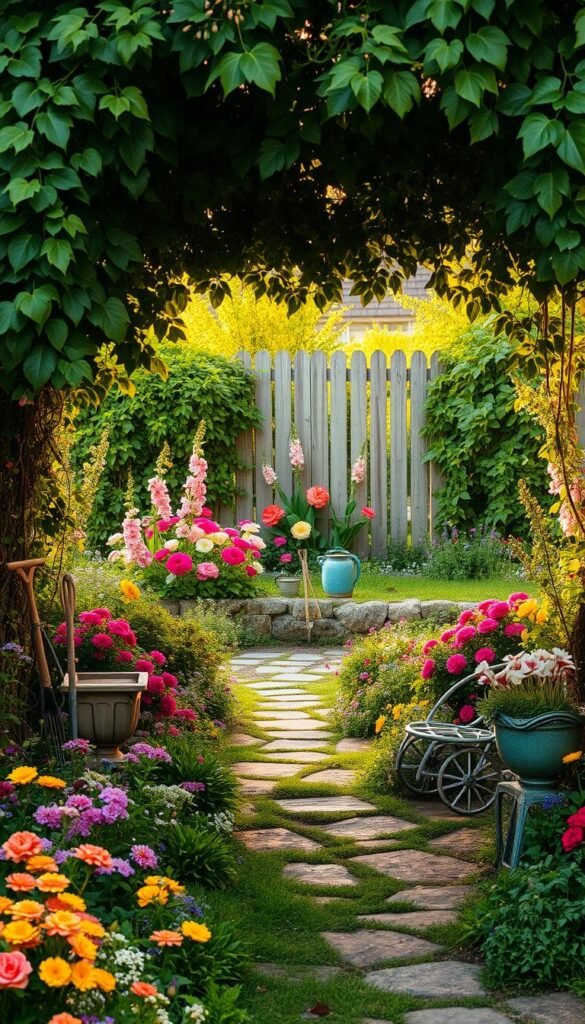
Discover how unstructured beauty transforms outdoor areas into living artworks. This approach thrives on balance—letting nature lead while adding thoughtful touches that feel collected over time. It’s not about strict rules but celebrating growth patterns and textures that whisper of simpler days.
Understanding Rustic Charm and Spontaneity
At its core, this garden style celebrates imperfections. Plants tumble over stone edges, while clover peeks between stepping stones. You’ll embrace soft color blends—think blush roses against lavender spires—with occasional bursts of crimson poppies for contrast. This organic approach creates spaces that feel lived-in, where even “weeds” might earn a spot if they charm pollinators.
The Allure of English Country Gardens
Drawing inspiration from historic landscapes, modern designs mix edibles and ornamentals. Hollyhocks tower beside thyme, while nasturtiums cascade near lettuce patches. Recent searches for cottage gardens surged 125%, reflecting a craving for spaces that blend productivity with poetry. By choosing versatile plants, you create layers that shift with the seasons—peonies in spring, sunflowers in summer, and ornamental grasses in autumn.
Remember: successful designs balance wildness with intention. Allow self-seeding blooms to find their place, but curate plant partnerships for year-round interest. The result? A space that feels both timeless and uniquely yours.
Cottagecore Garden Aesthetic: Weaving Rustic Charm into Your Flower Beds
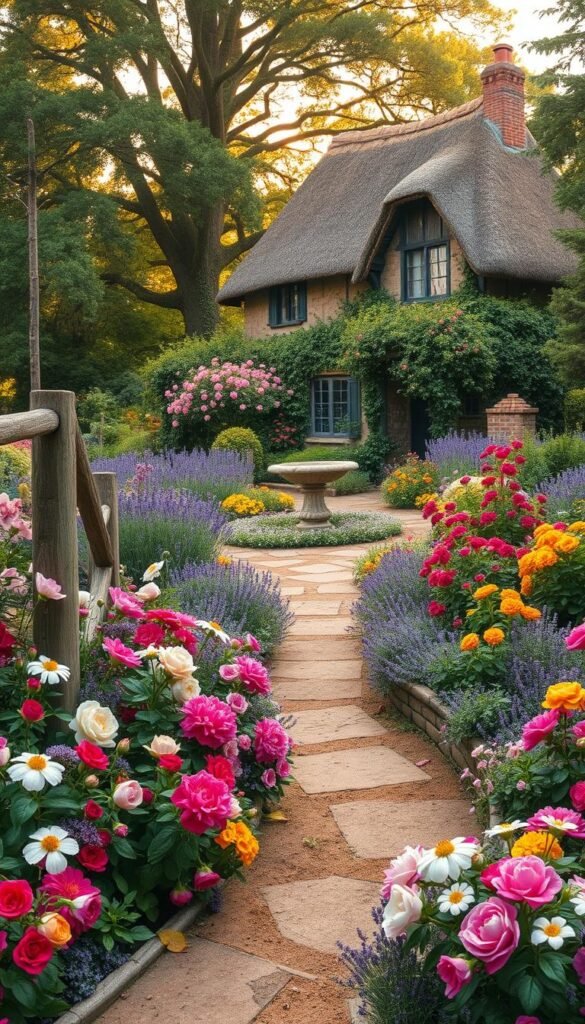
Build your landscape like nature’s own quilt—stitched with layers of greenery and bursts of seasonal hues. Start by anchoring your space with small trees like dogwoods or crabapples. These taller elements frame the scene while shrubs like hydrangeas add mid-height structure. Below them, let perennials like peonies mingle with self-seeding annuals for a dynamic, ever-changing base.
Diversity fuels both beauty and balance. Combine feathery cosmos with broad-leafed hostas, or pair spiky lavender with velvety lamb’s ear. This mix of textures invites touch while supporting bees and butterflies. Studies show biodiverse plots host 30% more pollinators than monoculture beds, creating a self-sustaining ecosystem.
Design with loose intention. Allow foxgloves to tower behind low-growing thyme, then let creeping phlox spill onto pathways. The secret? Contrast heights and forms without rigid rules. As plants mature, they’ll weave together like threads in a tapestry—structured yet free-flowing.
For unpredictable charm, blend edibles like kale with ornamentals. Swiss chard’s ruby stems pop against daisy clusters, while rosemary’s fragrance enhances the sensory experience. Need inspiration? Explore ideas for elevating your space through thoughtful plant pairings.
Finally, embrace imperfection. Let mint wander near stone borders or allow clover to carpet bare patches. These “happy accidents” mirror wild meadows, grounding your design in organic authenticity.
Selecting the Perfect Plants and Materials
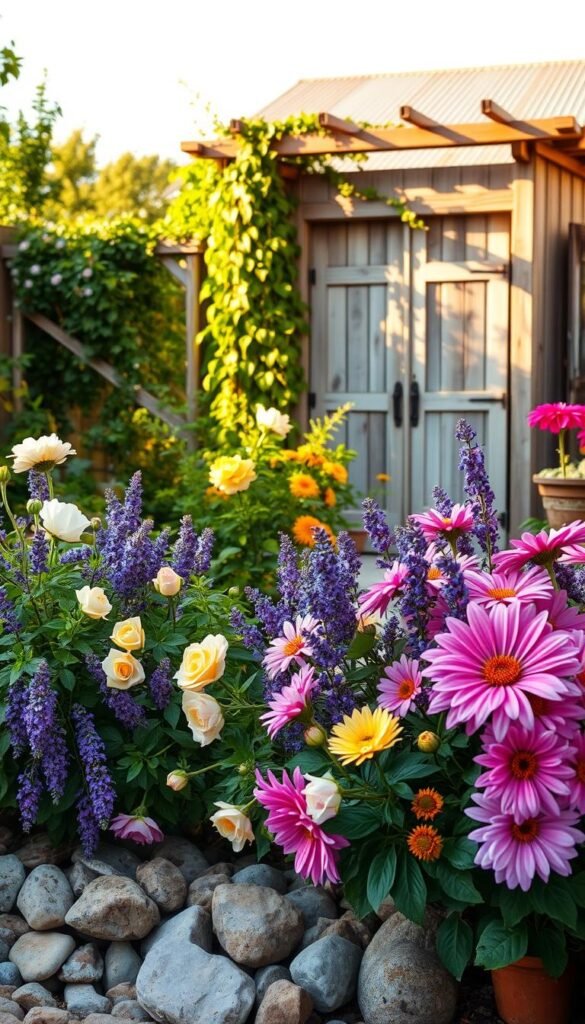
The heart of a timeless outdoor space lies in thoughtful plant selection and material choices. Start by choosing varieties that balance visual appeal with practical benefits, creating layers of color and purpose.
Flowering Plants, Herbs, and Vegetables for Vibrant Beds
Heirloom roses anchor designs with historical charm. Rosa ‘Great Maiden’s Blush’ offers blush-pink clusters and a clean, honey-like scent, while ‘Reine des Violettes’ stuns with lilac-purple blooms that deepen in color. Pair these with perennials like coral bells for burgundy foliage and delphiniums for sky-blue spires.
Mix edible and ornamental varieties for dual-purpose beauty. Lavender borders deter deer while attracting bees, and nasturtium leaves add peppery zest to salads. Sage’s silvery leaves contrast beautifully with bee balm’s scarlet flowers, proving functionality and style coexist.
Choosing Materials That Enhance Your Style
Natural textures ground your design. Weathered wood arbors support climbing roses, while local stone paths blend seamlessly with creeping thyme. Aged brick edging creates defined beds without harsh lines, letting plants spill over naturally.
Opt for materials that patina gracefully. Iron benches develop rust tones that complement autumn foliage, and terra-cotta pots acquire mossy character over time. These elements mature alongside your plantings, deepening the space’s authentic feel.
Designing Intimate and Enclosed Outdoor Spaces
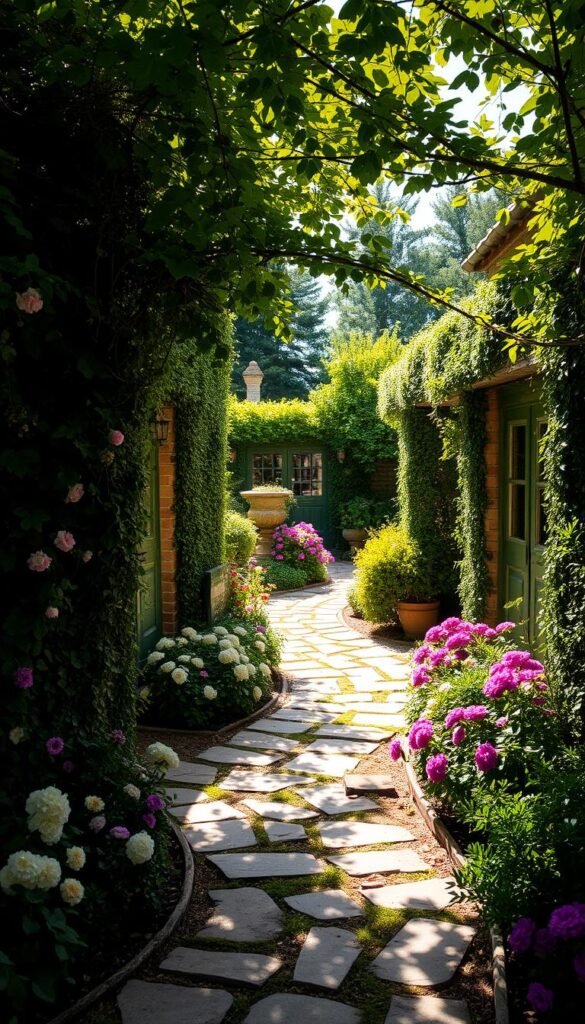
Transform your landscape into a collection of secret sanctuaries where every turn invites discovery. Soft curves and layered greenery create natural boundaries, turning open areas into cozy retreats that feel both private and connected to the larger environment.
Curved Pathways and Hidden Nooks for Mystery
Swap straight lines for meandering walkways lined with feathery grasses or low-growing thyme. A bend in the path creates anticipation—what blooms might appear around the corner? Use arching shrubs like hydrangeas to partially screen seating areas, letting dappled sunlight filter through.
Add unexpected elements: a weathered bench tucked behind climbing roses or a stone birdbath surrounded by catmint. These surprises engage the senses while maintaining your space’s relaxed vibe. Studies show curved designs increase perceived exploration time by 40%, making small areas feel expansive.
Establishing Zoned Areas for Dining, Relaxation, and Growth
Define distinct garden rooms using mixed-height plantings. A dining patio framed by dwarf fruit trees offers shade and snacks for al fresco meals. Nearby, lavender-edged gravel paths lead to a secluded reading nook with weather-resistant wicker chairs.
Blend function and beauty by bordering vegetable plots with marigolds or nasturtiums. For smooth transitions between zones, try stepping stone pathways flanked by creeping phlox. This approach maintains flow while giving each area its own personality—like chapters in a beloved storybook.
Integrating Outdoor Furniture and Rustic Accessories
Complete your landscape with pieces that invite lingering moments. Durable materials and cozy arrangements turn functional spaces into extensions of your home, blending comfort with nature’s rhythms.
Weather-Resistant Pieces for Year-Round Comfort
Choose outdoor furniture built to age gracefully. Treated teak benches develop silvery patinas, while powder-coated aluminum tables resist rust. These materials thrive through summer heat and winter frosts, requiring minimal upkeep.
Look for synthetic rattan dining sets with UV-resistant coatings. They maintain vibrant colors for alfresco meals under maple trees. Add cushions in fade-proof fabrics to create inviting seating that withstands afternoon showers.
Blending Style with Practical, Cozy Seating
Arrange sofa sets near flowering borders for immersive relaxation. Wrought iron loveseats with floral cushions nestle perfectly between hydrangea bushes. For hidden nooks, try wooden Adirondack chairs with water-repellent finishes.
Enhance functionality with accessories like galvanized planters doubling as side tables. Weatherproof storage trunks keep throws dry while adding vintage character. Every piece should feel collected over time – like your garden itself.

